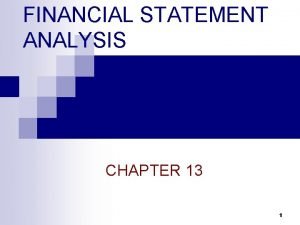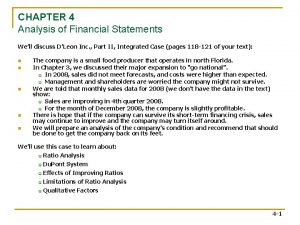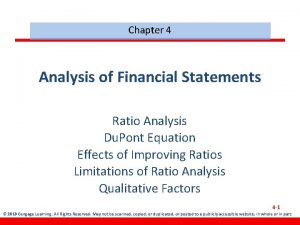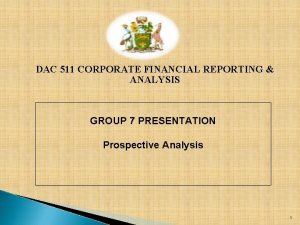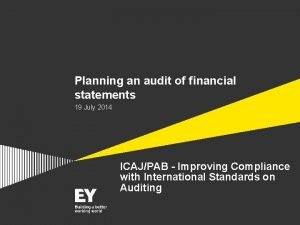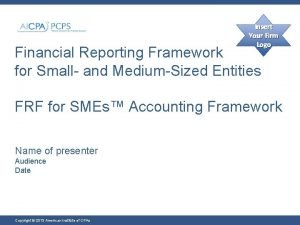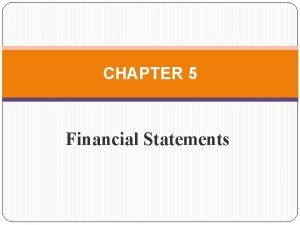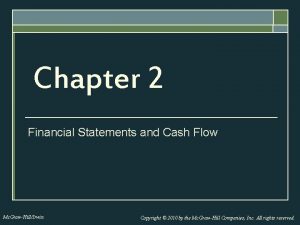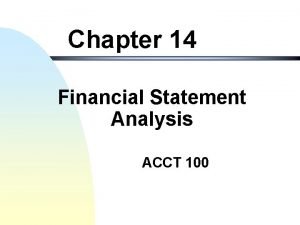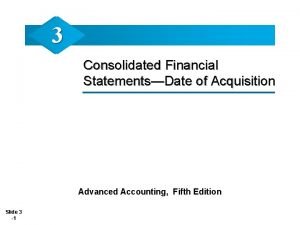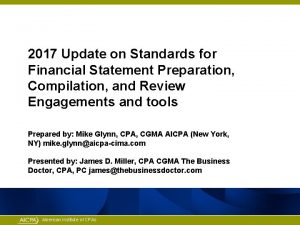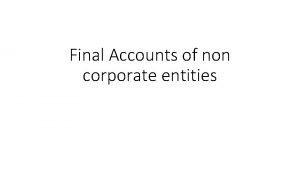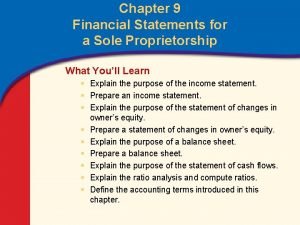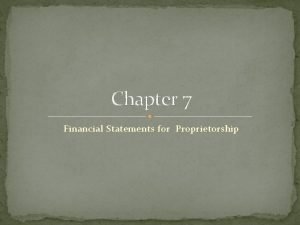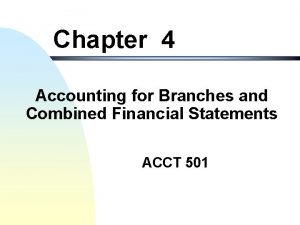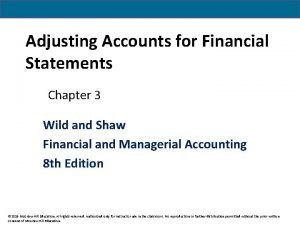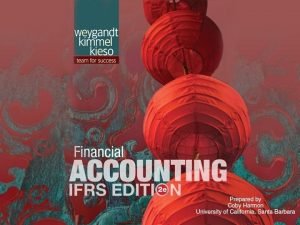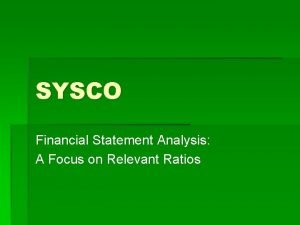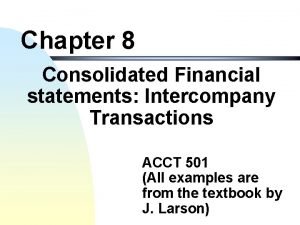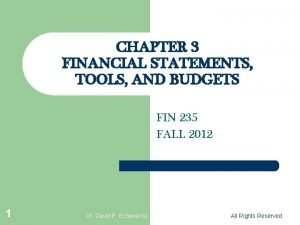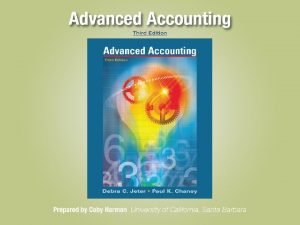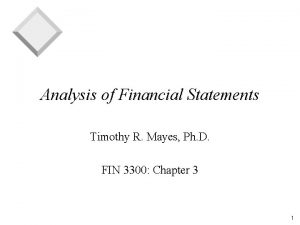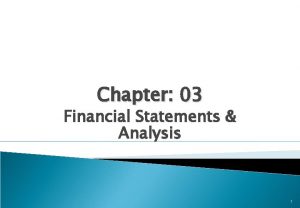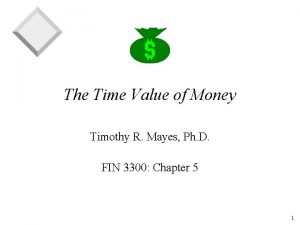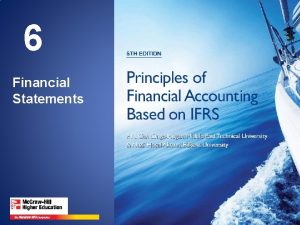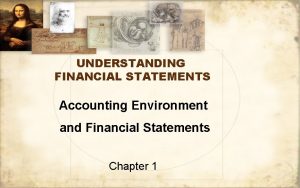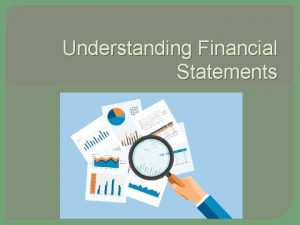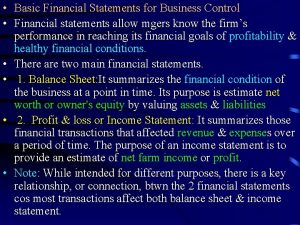Analysis of Financial Statements Timothy R Mayes Ph







































- Slides: 39

Analysis of Financial Statements Timothy R. Mayes, Ph. D. FIN 3300: Chapter 3 1

Common-size Income Statements v v A common-size income statement restates all expenses as a percentage of sales This allows the analyst to quickly and easily see which expenses have increased or decreased relative to sales 2

Common-size Balance Sheets v v A common-size balance sheet restates all assets and liabilities as a percentage of total assets This allows the analyst to quickly and easily see which accounts have increased or decreased relative to total assets 3

Financial Ratios v v Financial ratios are the analyst’s microscope; they allow us to get a better view of the firm’s financial health than just looking at the raw financial statements Ratios are used by both internal and external analysts • Internal uses planning u evaluation of management u • External uses credit granting u performance monitoring u investment decisions u 4

Categories of Financial Ratios v Financial ratios are often divided into categories based on the information that they provide: • • • Liquidity Efficiency Leverage Coverage Profitability Market valuation 5

Liquidity Ratios ‘Liquidity’ refers to the speed with which an asset can be converted to cash v Liquidity ratios describe the ability of a firm to meet its current obligations v There are three common liquidity ratios: v • The Current Ratio • The Quick Ratio • The Cash Ratio 6

The Current Ratio For EPI the current ratio in 1997 is: 7

The Quick Ratio For EPI the quick ratio in 1997 is: 8

The Cash Ratio For EPI the cash ratio in 1997 is: 9

Efficiency Ratios v The efficiency ratios (A. K. A. assets utilization ratios) describe how well a firm is using its investment in various asset classes: • • • Inventory Turnover Ratio Accounts Receivable Turnover Ratio Average Collection Period Fixed Asset Turnover Ratio Total Asset Turnover Ratio 10

The Inventory Turnover Ratio For EPI the inventory turnover ratio in 1997 is: 11

The A/R Turnover Ratio For EPI the accounts receivable turnover ratio in 1997 is: 12

The Average Collection Period For EPI the average collection period in 1997 is: 13

The Fixed Asset Turnover Ratio For EPI the fixed asset turnover ratio in 1997 is: 14

The Total Asset Turnover Ratio For EPI the total asset turnover ratio in 1997 is: 15

Leverage Ratios v Leverage ratios describe the amount of debt that the firm has used to finance its investments in assets: • • Total Debt Ratio Long-term Debt Ratio Debt to Equity Long-term Debt to Equity 16

The Total Debt Ratio For EPI the total debt ratio in 1997 is: 17

The Long-term Debt Ratio For EPI the long-term debt ratio in 1997 is: 18

The Debt to Equity Ratio For EPI the debt to equity ratio in 1997 is: 19

The Long-term Debt to Equity Ratio For EPI the long-term debt to equity ratio in 1997 is: 20

Coverage Ratios v Coverage ratios indicate the firm’s ability to pay certain expenses: • Times Interest Earned Ratio • Cash Coverage Ratio 21

The Times Interest Earned Ratio For EPI the times interest earned ratio in 1997 is: 22

The Cash Coverage Ratio For EPI the cash coverage ratio in 1997 is: 23

The Fixed Charge Coverage Ratio v Note: SF Payments are Sinking Fund payments which are not tax deductible. Therefore, we must divide them by (1 -t) to find out how much we need before taxes to meet this after-tax expense. Also, you must include preferred dividends in this number. 24

Profitability Ratios v Profitability ratios provide a measure of the returns that a firm is generating: • • • Gross Profit Margin Operating Profit Margin Net Profit Margin Return on Total Assets Return on Equity Return on Common Equity 25

The Gross Profit Margin For EPI the gross profit margin in 1997 is: 26

The Operating Profit Margin For EPI the operating profit margin in 1997 is: 27

The Net Profit Margin For EPI the net profit margin in 1997 is: 28

The Return on Total Assets For EPI the return on total assets in 1997 is: 29

The Return on Equity For EPI the return on equity in 1997 is: 30

The Return on Common Equity For EPI the return on common equity in 1997 is: 31

Market Valuation Ratios v The market valuation ratios provide an indication of the relative under- or over-pricing of a firm’s stock: • Price/Earnings Ratio • Price/Book Ratio 32

The Price/Earnings Ratio 33

The Price/Book Ratio 34

Rules for Memorizing Ratios v There can be an infinite number of financial ratios, but knowing a few basic rules will help you to memorize the formulas: The basic rule is that the name tells you how to calculate the ratio. • Any ‘margin’ ratio is something divided by sales • Any ‘turnover’ ratio is sales (or a variation of sales) divided by something • Any ‘return on’ ratio is net income (or a variation of net income) divided by something 35

Using Financial Ratios v v v Calculating ratios is pointless unless you know how to use them The most basic rule is: a single ratio provides very little information and may be misleading With that in mind, there at least 4 uses of ratios: • • Trend analysis (internal and external) Comparison to industry averages (internal and external) Setting and evaluating company goals (internal) Restrictive debt covenants (external) 36

Trend Analysis of Ratios v v v Trend analysis involves the examination of ratios over time The analyst tries to determine if the ratio is changing in a favorable, or unfavorable, direction The chart shows EPI’s current ratio for two years (we really need more data) 37

Comparing to Industry Averages v v v Industry average ratios provide a benchmark for comparison We assume that if a ratio is too far from the average something is wrong Industry ratios are available from Robert Morris Associates and Standard & Poor’s 38

Company Goals and Debt Covenants v Company goals are often stated in terms of financial ratios • For example, it is common for management to set goals regarding the firm’s ROE v Debt covenants often contain restrictions on certain ratios • For example, a borrower might be required to maintain a debt to equity ratio of less than 1. 0 and a current ratio greater than 2. 0 39
 Jade mayes
Jade mayes Parabolic microphone definition
Parabolic microphone definition Dr s chris mayes
Dr s chris mayes Dr david mayes
Dr david mayes Chapter 13 financial statement analysis
Chapter 13 financial statement analysis Chapter 03 financial analysis
Chapter 03 financial analysis Chapter 4 analysis of financial statements
Chapter 4 analysis of financial statements Chapter 4 analysis of financial statements
Chapter 4 analysis of financial statements How to improve current ratio
How to improve current ratio Prospective analysis financial statements
Prospective analysis financial statements Financial statement of commercial bank
Financial statement of commercial bank Financial report purpose
Financial report purpose Audit planning memorandum ey
Audit planning memorandum ey Sample notes to financial statements for small entities
Sample notes to financial statements for small entities Financial statement translation example
Financial statement translation example Objectives of financial statements
Objectives of financial statements Cash flow to creditors is equal to
Cash flow to creditors is equal to Acct 100
Acct 100 Forecasted financial statements
Forecasted financial statements Adjusting accounts for financial statements chapter 3
Adjusting accounts for financial statements chapter 3 Consolidated financial statements date of acquisition
Consolidated financial statements date of acquisition Ssars 21 engagement letter example
Ssars 21 engagement letter example Which item is a constraint in financial accounting?
Which item is a constraint in financial accounting? Ias 27
Ias 27 Standardized income statement
Standardized income statement Accounts
Accounts Financial statement of sole proprietorship
Financial statement of sole proprietorship Sole proprietorship financial statements
Sole proprietorship financial statements Reciprocal accounts in accounting
Reciprocal accounts in accounting Adjusting accounts for financial statements chapter 3
Adjusting accounts for financial statements chapter 3 Statement of performance format
Statement of performance format Four financial statements
Four financial statements Ifrs 17 effective date
Ifrs 17 effective date Unit 13 accounting and financial statements
Unit 13 accounting and financial statements Sysco financial statements
Sysco financial statements Four primary financial statements
Four primary financial statements Intercompany bond transactions
Intercompany bond transactions Financial statements tools
Financial statements tools Flow chapter 2
Flow chapter 2 Translating financial statements
Translating financial statements




